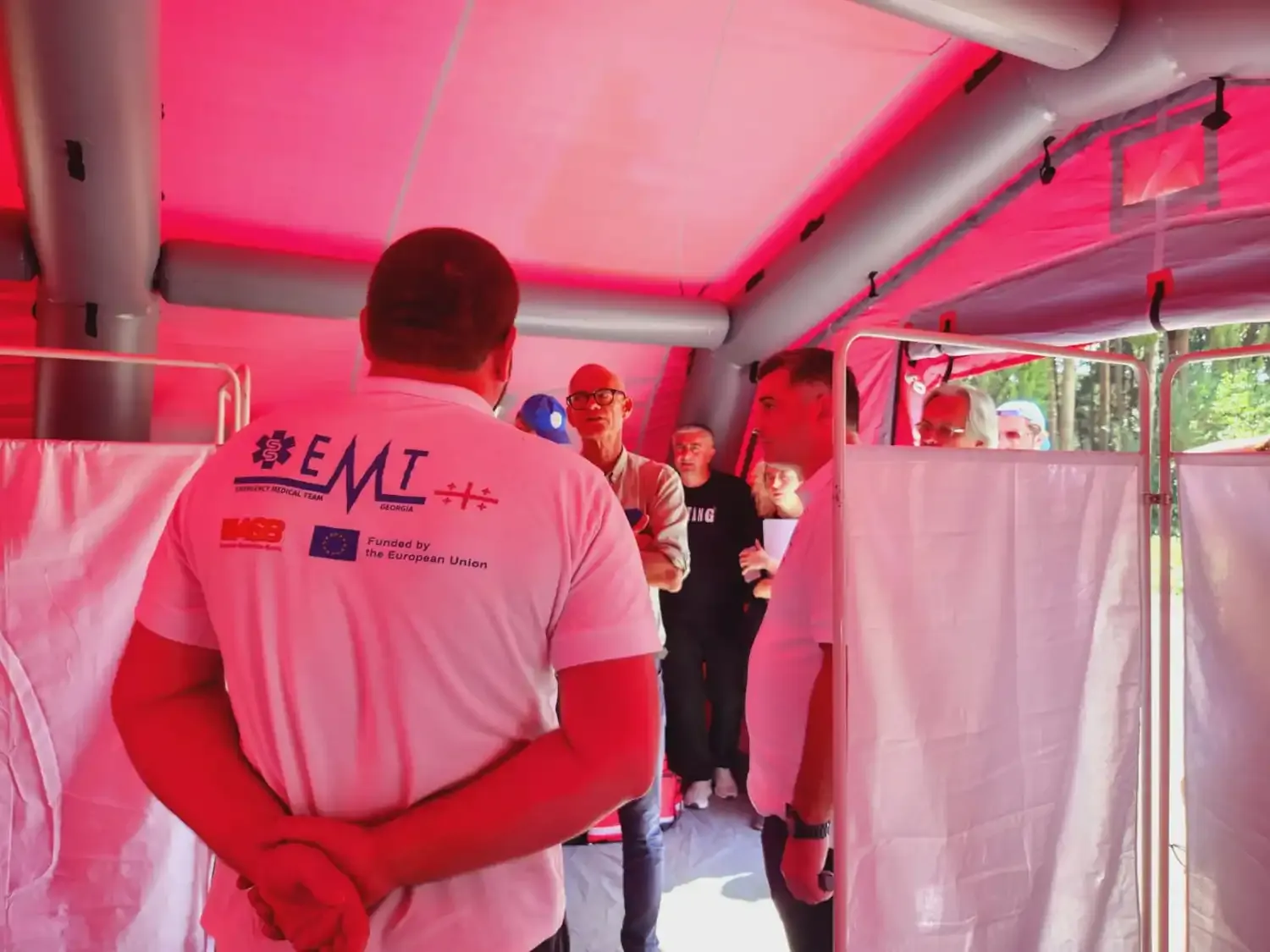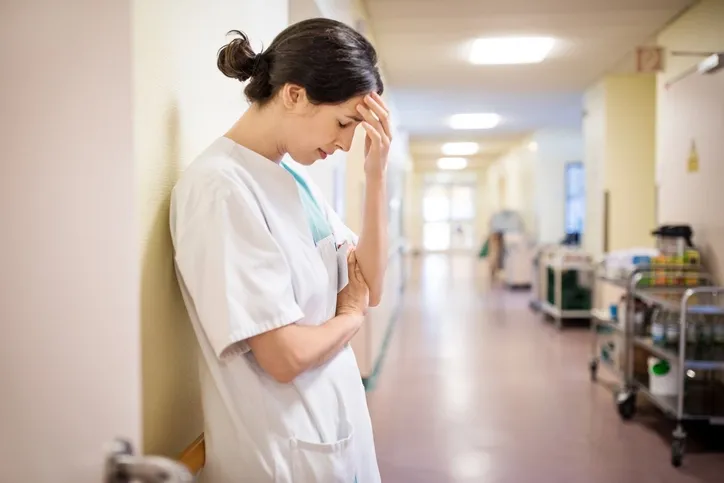Forskning på Global katastrofmedicin - hälsobehov och insatser
En katastrof kännetecknas av en brist på resurser: brist på personal, brist på kompetens, brist på material och brist på tid. Vår forskning handlar om utmaningen i hur vi, trots resursbristen, tillhandahåller bästa möjliga hälso- och sjukvård. För närvarande bedriver vi forskning inom fyra områden: behovsbedömning, moralisk stress, handhavande av krigsskador, och hälso- och sjukvårdssystemets motståndskraft. Professor Johan von Schreeb är huvudansvarig för vår forskning.

Emergency Medical Teams (EMTs):
Emergency Medical Teams (EMTs) är team av sjukvårdspersonal (läkare, sjuksköterskor, sjukgymnaster, ambulanspersonal etc.) som ger klinisk direkt vård till människor som drabbats av katastrofer och andra nödsituationer, samt stöder de lokala sjukvårdssystem. EMT är ett initiativ inom Världshälsoorganisationen (WHO). Det finns över 40 team i hela världen. De kan drivas antingen av enskilda länder eller av frivilligorganisationer och humanitära hjälporganisationer och kan användas både nationellt och internationellt.
Vår forskargruppsledare, Johan von Schreeb, var med och startade initiativet 2010 efter den kaotiska internationella responsen på jordbävningen i Haiti samma år. Han har bidragit till att utveckla EMT-initiativet på flera sätt, bland annat var medförfattare i den första versionen av "Blue Book" (Classification and Standards for Foreign Medical Teams in Sudden Onset Disasters) och 2021 års version av Blue Book samt Red Book (A Guidance Document for Medical Teams Responding to Health Emergencies in Armed Conflicts and Other Insecure Environments).
Vår forskargrupp samlar in och analyserar data från katastrofer där EMT:er (både nationella och internationella) har använts, utvärderar deras insats och i vilken utsträckning de är integrerade i hälso- och sjukvårdssystemet i det drabbade området.
Förutom forskning stöder vi även EMT-initiativet på andra sätt. Vi fungerar som EMT-mentorer för organisationer som vill bli EMT-klassificerade, och vi deltar i verifieringsuppdrag, bidrar till utbildningar och informationstillfällen i länder som är intresserade av att starta EMT. Det arbetet beskrivs närmare på vår policy- och expertis-sida.
Behovsbedömning i katastrofer:
Syftet med behovsbedömningar vid katastrofer är att systematiskt ta reda på vilken typ av behov som finns för att utifrån det kunna planera hjälpinsatser på bästa sätt och maximera resursanvändningen. Behovsbedömningar är tidskänsliga och förlitar sig på snabba uppskattningar av allvarlighetsgraden av katastrofen och situationen den drabbade befolkningen, samt information om det drabbade områdets sårbarhet före katastrofen. Vår forskning om behovsbedömning vid katastrofer har resulterat två doktorsavhandlingar och utgör sedan länge en av grundpelarna i vårt arbete.
Vi fortsätter att arbeta med att utveckla metoder för att behovsbedömningar ska kunna göras i rätt tid och med hänsyn till konflikter och katastrofers föränderliga karaktär. Vi har skapat och testat en modell för att uppskatta och jämföra katastrofers allvarlighetsgrad, och vårt arbete fokuserar nu på att förutse katastrofers allvarlighetsgrad och de vårdbehov som kommer uppstå. För att göra detta använder vi data från katastrofer som inträffat nyligen, t.ex. jordbävningen 2023 i Turkiet och Syrien.
Väpnade konflikters påverkan på hälsa:
Vår forskning om behovsbedömning i katastrofer har möjliggjort vår medverkan i ett forskningsprojekt som heter Societies at Risk, där vi tittar på hur väpnade konflikter påverkar hälsan.
Societies at Risk - Anticipating the Impact of Armed Conflict är ett tvärvetenskapligt forskningsprojekt som undersöker effekterna av väpnade konflikter som en risk, exponering och sårbarhet. Det handlar om makro- och mikroeffekter på ekonomi, hälsa, vattensäkerhet, politiska institutioner, mänskliga rättigheter, jämställdhet och påtvingad migration. Syftet är att motverka fragmenteringen av forskning inom olika akademiska områden som begränsar vår förståelse, och istället, genom att arbeta tillsammans, lära oss mer om den fulla omfattningen av konflikternas effekter och hur de kan hanteras.
Vi ingår i Societies at Risk tillsammans med Uppsala universitet, Universitat Autònoma de Barcelona, International Security and Development Center (ISDC), Stockholms universitet, Johns Hopkins University, University of Pittsburgh och V-Dem vid Göteborgs universitet. Projektet syftar till att tillhandahålla en omfattande, tvärvetenskaplig och framåtblickande bedömning som kan bidra till välgrundat beslutsfattande och preventiva åtgärder. Målet är att utveckla ett omfattande riskbaserat ramverk för att empiriskt bedöma den förväntade effekten av väpnade konflikter på mänsklig utveckling. Vår forskningsspecialist Anneli Eriksson driver vår forskning inom projektet.
Vår forskning inom projektet handlar om att förstå hur väpnade konflikter påverkar hälsan. Hittills har vi bidragit till litteraturöversikter och genomfört kohortstudier för att undersöka om det finns några samband mellan konfliktintensitet och hälsoutfall på regional nivå i två samtida väpnade konflikter. I två studier tittar vi på hälsoeffekter på landsnivå, i relation till konfliktintensitet och sårbarhet. Som en del av projektet genomför vi kvalitativa studier där vi försöker förstå hur människor hanterar vårdbehov under väpnade konflikter. Intervjuer har genomförts i Sverige med personer som har drabbats av konflikt och vi planerar att genomföra fokusgruppsdiskussioner i Ukraina och Libanon.
Krisers påverkan på efterfrågan och användning av hälso- och sjukvårdsinsatser:
I likhet med hur väpnade konflikter påverkar hälsan studerar vi också hur andra former av kriser påverkar efterfrågan på och användningen av hälso- och sjukvårdsinsatser. Vi studerar särskilt effekterna av översvämningar och andra former av extremväderhändelser. Dessutom tittar vi på hur hälso- och sjukvårdssystemen kan stärkas för att klara av kriser.
Vår biträdande lektor Dell Saulnier är med och leder en del av ett REACH-projekt som handlar om att bedöma hur översvämningar och extrem värme påverkar användning och tillgång till mödra- och barnhälsovård, med fokus på Brasilien och Zambia. Syftet är att bättre förstå vilka egenskaper som gör systemet sårbart för översvämningar och värme, samt vilka egenskaper som gör det motståndskraftigt.
Hälsosystemsresiliens:
Vår forskning inom hälsosystemsresiliens fokuserar främst på att identifiera egenskaper och beteenden som skapar och upprätthåller resiliens. I det arbetet tittar vi på beslutsstrukturer, kunskapsdelning, förtroende och ömsesidigt beroende.
För närvarande sker det arbetet bland annat genom vår medverkan i ett forskningsprojekt, finansierat av Forte, som undersöker hälso- och sjukvårdssystemens motståndskraft i hanteringen av covid-19-pandemin och vilka lärdomar som kan dras av regionala beredskapsplaner i Sverige.
Vi studerar också frågor som rör makt inom resiliens och inom resultaten av resiliensinitiativ, samt identifierar trösklarna mellan de tre viktigaste resiliensförmågorna för olika typer av kriser.
Vårt arbete inom området innefattar också ett projekt som undersöker den privata sektorns roll för att skapa resiliens i hälso- och sjukvårdssystemet, genom en fallstudie i Zambia. Det projektet finansieras av Vetenskapsrådet. Det fokuserar särskilt på den roll som vinstdrivande och icke-vinstdrivande aktörer inom den privata sektorn spelar för resiliens, till exempel genom informationsutbyte mellan sektorer, förtroende och legitimitet samt organisatorisk resiliens. Syftet med projektet är att:
- Identifiera svagheter och utmaningar i processen för att dela information om COVID-19-test mellan offentliga och privata hälso- och sjukvårdsanläggningar i Zambia för användning vid övervakning och uppföljning av sjukdomar
- Förstå befolkningens uppfattning om förtroendet för hälso- och sjukvårdstjänster inom den privata sektorn jämfört med offentliga tjänster under covid-19-pandemin
Systemtänkande inom hälsosystem:
Systemtänkande inom hälso- och sjukvårdssystem är ett tillvägagångssätt för att förstå komplexiteten i problem inom området genom att titta på dem holistiskt, se dem som sammankopplade och förstå relationerna och interaktionerna mellan systemets intressenter och delar. Vår biträdande lektor Dell Saulnier är en av grundarna av den europeiska sektionen av nätverket Systems Thinking Accelerator (SYSTAC) som främjar systemtänkande för hälso- och sjukvårdssystem.
Vi leder för närvarande ett projekt som tittar på det relationen mellan social sjukförsäkring (SHI) och finansiellt skydd, utnyttjande och hälsoutfall. Projektet fokuserar på Kambodja och finansieras av Vetenskapsrådet. Syftet med projektet är att:
- Förstå hur, varför och under vilka omständigheter SHI-system påverkar primärvårdsrelaterade hälsoresultat i låg- och medelinkomstländer
- Fastställa effekten av Kambodjas reform av den allmänna sjukförsäkringen på utnyttjandet av primärvårdstjänster och finansiellt skydd bland försäkringstagarna
- Bedöma hur reformen påverkar de primärvårdsrelaterade hälsoresultaten för försäkringstagarna
- Undersöka uppfattningar på efterfråge- (medlemmar i systemet) och utbudssidan (aktörer inom primärvårdssystemet) om hur den kambodjanska sjukförsäkringen påverkar det ekonomiska skyddet och utnyttjandet av primärvårdstjänster
- Förstå hur det kambodjanska SHI-systemet påverkar primärvårdsrelaterade hälsoresultat

Moralisk stress och etiska utmaningar inom katastrofer:
Den resursbrist som kännetecknar katastrofer medför moraliska utmaningar för hälso- och sjukvården som går utöver dem som råder under normala omständigheter. I katastrofinsatser befinner sig vårdpersonalen i nya, ofta hotfulla, situationer där de måste fatta svåra beslut för att prioritera bland överväldigande behov. De yrkesetiska riktlinjer som finns är av begränsad nytta eftersom de inte i tillräcklig utsträckning tar hänsyn till katastrofernas komplexitet och den press som personalen arbetar under.
Vår forskning syftar till att bättre förstå vilka faktorer som är avgörande för moralisk stress och vad som kan göras för att förebygga sjukdom och lidande. I början av 2024 försvarade Martina Gustavsson sin doktorsavhandling, med titeln Moral conflicts in health crises: Swedish health care workers' experiences and management of moral stress, inom ämnet. Hon är fortfarande anknuten till vår grupp och fortsätter att bedriva forskning inom området.
Kvalitetsbedömning av intensivvård i hälsokriser och lågresurskontexter:
Vi har tidigare utvecklat och implementerat verktyg för att bedöma kvaliteten på intensivvården av kritiskt sjuka patienter under covid-19-pandemin i Libanon. Behovet av sådana verktyg fortfarande stort, både i lågresurskontexter, som befintliga verktyg för kvalitetsbedömning är dåligt lämpade för, på grund av brist på system för datainsamling, och i höginkomstländer, där vården under en hälsokris måste skalas upp och bedrivas utanför de ordinarie strukturerna. Vi förbereder för närvarande ett större projekt för att utveckla ett verktyg för kvalitetsbedömning som ska användas inom intensivvård i resursbegränsade miljöer.
Prioritering till intensivvård i hälsokriser:
I en hälsokris, oavsett vad som har orsakat den, ökar i regel antalet patienter som behöver intensivvård. Trots en uppskalning av vården kan det uppstå en situation där antalet patienter överstiger den tillgängliga vården och prioriteringar måste göras.
Sverige saknar en tydlig, transparent och kliniskt tillämpbar prioriteringsordning för patienter till intensivvård. Vi har genomfört en pilotstudie om attityder till prioritering av patienter till intensivvård bland läkarstudenter och vår plan är att utveckla detta till ett större projekt för att studera attityder bland befolkningen.
Tidigare forskning:
Under våra över tjugo år av forskning har vi täckt flera ämnen inom katastrofmedicin och varit involverade i flera forskningsprojekt.
Av de senaste kan nämnas:
- Undernäring och amning i humanitära kriser. Inom vår grupp har vi en lång samlad erfarenhet av att både arbeta, forska och undervisa i ämnet undernäring och amning i humanitära kriser. Amning i humanitära kriser var ämnet för vår forskningsanknutna Nieves Amat Camachos doktorsavhandling med titeln Feeding in crisis - Exploring the Provision of Breastfeeding Support during Humanitarian Emergencies. Efter sin doktorsexamen har hon fortsatt att handleda masterstudenter som skriver sina avhandlingar om undernäring hos mödrar och öppenvårdsbehandling av spädbarn under 6 månader med risk för dålig tillväxt och utveckling.
- Bedömning av graden av självständighet och förmåga att utföra dagliga aktiviteter efter skada för patienter i humanitära kriser. Bérangére Gohy skrev sin doktorsavhandling, Independence in activities after injury in humanitarian settings: assessment, change over time and associated factors inom det här ämnet 2023
- Hantering av konfliktskador - Lokal undertrycksbehandling för skott- och explosionsskador. Andreas Älgå försvarade sin doktorsavhandling, Wounds of war: surgical care for conflict-related injuries among civilians in resource-limited settings inom ämnet 2019
- Epidemiologi av konfliktrelaterat trauma i samtida väpnade konflikter
